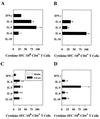Expression of recombinant enterotoxigenic Escherichia coli colonization factor antigen I by Salmonella typhimurium elicits a biphasic T helper cell response
- PMID: 10569734
- PMCID: PMC97026
- DOI: 10.1128/IAI.67.12.6249-6256.1999
Expression of recombinant enterotoxigenic Escherichia coli colonization factor antigen I by Salmonella typhimurium elicits a biphasic T helper cell response
Abstract
Protective immunity to enterotoxigenic Escherichia coli (ETEC) is antibody (Ab) dependent; however, oral immunization with purified ETEC fimbriae fails to elicit protective immunity as a consequence of antigenic alteration by the gastrointestinal (GI) tract. Unless unaltered ETEC fimbriae can reach the inductive lymphoid tissues of the GI tract, immunity to ETEC cannot be induced. To produce immunity, live vectors, such as Salmonella typhimurium, can effectively target passenger antigens to the inductive lymphoid tissues of the GI tract. By convention, oral immunizations with Salmonella vectors induce CD4(+) T helper (Th) cell responses by gamma interferon (IFN-gamma)-dominated pathways both to the vector and passenger antigen, resulting in serum immunoglobulin G2a (IgG2a) and modest mucosal IgA Ab responses. In the present study, mice orally immunized with a Salmonella vector engineered to stably express ETEC colonization factor antigen I (CFA/I) showed initially elevated serum IgG1 and mucosal IgA anti-CFA/I Ab responses. As expected, mice orally immunized with an E. coli-CFA/I construct elicited poor anti-CFA/I Ab responses. In fact, the addition of cholera toxin during oral E. coli-CFA/I immunization failed to greatly enhance mucosal IgA Ab responses. Seven days after immunization with the Salmonella-CFA/I construct, cytokine-specific ELISPOT showed induction of predominant Th2-type responses in both mucosal and systemic immune compartments supporting the early IgG1 and IgA anti-CFA/I Abs. By 4 weeks, the Th cell response became Th1 cell dominant from the earlier Th2-type responses, as evidenced by increased mucosal and systemic IFN-gamma-producing T cells and a concomitant elevation of serum IgG2a Ab responses. This biphasic response offers an alternative strategy for directing Salmonella vector-induced host immunity along a Th2 cell-dependent pathway, allowing for early promotion of mucosal and systemic Abs.
Figures







Similar articles
-
Oral immunization with a Salmonella typhimurium vaccine vector expressing recombinant enterotoxigenic Escherichia coli K99 fimbriae elicits elevated antibody titers for protective immunity.Infect Immun. 1998 Nov;66(11):5470-6. doi: 10.1128/IAI.66.11.5470-5476.1998. Infect Immun. 1998. PMID: 9784559 Free PMC article.
-
Combined vaccine regimen based on parenteral priming with a DNA vaccine and administration of an oral booster consisting of a recombinant Salmonella enterica serovar Typhimurium vaccine strain for immunization against infection with human-derived enterotoxigenic Escherichia coli strains.Infect Immun. 2004 Nov;72(11):6480-91. doi: 10.1128/IAI.72.11.6480-6491.2004. Infect Immun. 2004. PMID: 15501779 Free PMC article.
-
Impaired mucosal immunity in L-selectin-deficient mice orally immunized with a Salmonella vaccine vector.J Immunol. 2001 Jul 1;167(1):407-15. doi: 10.4049/jimmunol.167.1.407. J Immunol. 2001. PMID: 11418677
-
The role of Th1 and Th2 cells for mucosal IgA responses.Ann N Y Acad Sci. 1996 Feb 13;778:64-71. doi: 10.1111/j.1749-6632.1996.tb21115.x. Ann N Y Acad Sci. 1996. PMID: 8611017 Review.
-
Mucosal immunity: regulation by helper T cells and a novel method for detection.J Biotechnol. 1996 Jan 26;44(1-3):209-16. doi: 10.1016/0168-1656(95)00095-X. J Biotechnol. 1996. PMID: 8717406 Review.
Cited by
-
M cell-targeted DNA vaccination.Proc Natl Acad Sci U S A. 2001 Jul 31;98(16):9318-23. doi: 10.1073/pnas.161204098. Epub 2001 Jul 17. Proc Natl Acad Sci U S A. 2001. PMID: 11459939 Free PMC article.
-
Comparison of a regulated delayed antigen synthesis system with in vivo-inducible promoters for antigen delivery by live attenuated Salmonella vaccines.Infect Immun. 2011 Feb;79(2):937-49. doi: 10.1128/IAI.00445-10. Epub 2010 Dec 6. Infect Immun. 2011. PMID: 21134969 Free PMC article.
-
A colanic acid operon deletion mutation enhances induction of early antibody responses by live attenuated Salmonella vaccine strains.Infect Immun. 2013 Sep;81(9):3148-62. doi: 10.1128/IAI.00097-13. Epub 2013 Jun 17. Infect Immun. 2013. PMID: 23774599 Free PMC article.
-
Enhanced immunoglobulin A response and protection against Salmonella enterica serovar typhimurium in the absence of the substance P receptor.Infect Immun. 2005 Jan;73(1):317-24. doi: 10.1128/IAI.73.1.317-324.2005. Infect Immun. 2005. PMID: 15618168 Free PMC article.
-
Regulatory T cell vaccination without autoantigen protects against experimental autoimmune encephalomyelitis.J Immunol. 2007 Feb 1;178(3):1791-9. doi: 10.4049/jimmunol.178.3.1791. J Immunol. 2007. PMID: 17237429 Free PMC article.
References
-
- Black R E, Brown K H, Becker S, Alim A, Huq I. Longitudinal studies of infectious diseases and physical growth of children in rural Bangladesh: II. Incidence of diarrhea and association with known pathogens. Am J Epidemiol. 1982;115:315–324. - PubMed
-
- Black R E. The epidemiology of cholera and enterotoxigenic Escherichia coli diarrheal disease. In: Holmgren J, Lindberg A, Molby R, editors. Development of Vaccines and Drugs Against Diarrhea. Stockholm, Sweden: Studentlitteratur; 1986. pp. 23–32.
-
- Curtiss R, Kelly S M, Gulig P A, Nakayama K. Selective delivery of antigens by recombinant bacteria. Curr Top Microbiol Immunol. 1989;146:34–49. - PubMed
-
- Curtiss R, Kelly S M, Hassan J O. Live oral avirulent Salmonellavaccines. Vet Microbiol. 1993;37:397–405. - PubMed
Publication types
MeSH terms
Substances
Grants and funding
LinkOut - more resources
Full Text Sources
Other Literature Sources
Medical
Research Materials
Miscellaneous

